
| WWT Shows | CLICK TO: Join and Support Internet Horology Club 185™ | IHC185™ Forums |

|
• Check Out Our... • • TWO Book Offer! • |
Welcome Aboard IHC185™  Internet Horology Club 185
Internet Horology Club 185  IHC185™ Discussion Site Main Page
IHC185™ Discussion Site Main Page  Horological Discussions, Questions and Answers
Horological Discussions, Questions and Answers  Military Timepiece Discussions - EXCLUSIVE!
Military Timepiece Discussions - EXCLUSIVE!  H.White & Co Ltd, London. Pre-WW1 P.W.
H.White & Co Ltd, London. Pre-WW1 P.W.
 Internet Horology Club 185
Internet Horology Club 185  IHC185™ Discussion Site Main Page
IHC185™ Discussion Site Main Page  Horological Discussions, Questions and Answers
Horological Discussions, Questions and Answers  Military Timepiece Discussions - EXCLUSIVE!
Military Timepiece Discussions - EXCLUSIVE!  H.White & Co Ltd, London. Pre-WW1 P.W.
H.White & Co Ltd, London. Pre-WW1 P.W.Related Content: European Pocket Watch Forum
Go  | New Topic  | Find-Or-Search  | Notify  | Tools  | Reply to Post  |  |
Hi All, Another one of my Military Pocket Watches for your perusal, any comments welcome. The Dial and movement are signed H. White & Co Ltd, 65, Cheapside, London. Both the dial and movements also have the 'broad arrow', but no other markings at all. The case body, covers, movement and dial all have the same serial number '2079' The 'open face' case is assay marked for London 1912, but with no silver 'grade' mark. It appears totally unused with no wear to speak of anywhere, not even on the gold plated crown, which is spotless even in the flutes! The casemaker's marks 'ATO' would be: Albert Thoms Oliver. 31, Wynyatt St, Clerkenwell, London. (Mark Reg'd 1903) The 'Stem wind / Pin set' movement is likewise virtually untouched and high quality, right down to it's screwed in jewels and diamond endstone. It is missing its balance and lever (club toothed escape wheel) and appears it may never have had them fitted, all the beautifully 'Blued' screws etc are absolutely pristine and look completely untouched. Even the back cock looks completely untouched with no sign of a hairspring stud ever having been fitted (or removed!). There is also no provision for an index lever, so assume it would have been calibrated purely by hairspring positioning. Could this have been an unused / un-issued Army watch? Anyone come across anything similar? Pic's posted below. Best regards John Woolsey 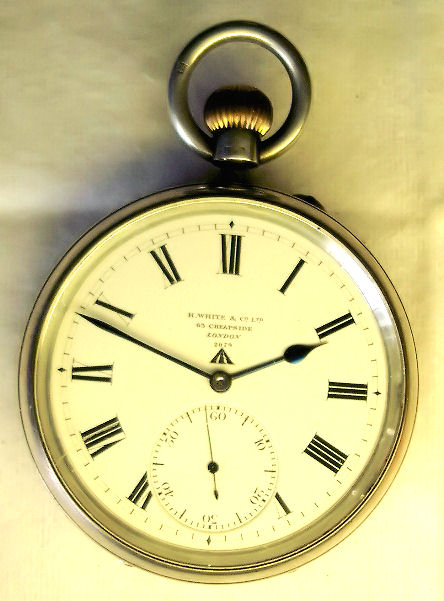 | |||
|
H. White & Co Ltd. Movement!  | ||||
|
H. White & Co Ltd, Case Hallmarks. 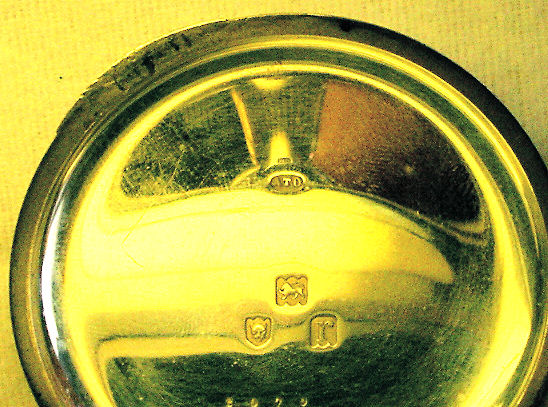 | ||||
|
| Life Achievement Military Expert |
A rather nice watch. I would guess it was intended as a comparing watch for the Royal Navy, but then something happend about the time it was delivered. I would guess the lever and balance may have been removed and sent to another watchmaker for re-staffing, only to be lost. Thus, the fine watch went into a drawer never fixed and never used. One wonders if it might not be possible to locate a similar movement and rework the fork and balance to fit this fine watch? Best regards, Greg | |||
|
This is a really beautiful example of a fine early military watch. I think that Greg's thought seems to be the most likely story. The only other possibility I can think of could be that the government's order was ended or changed in favor of the more modern watch specification one sees in the WW I era watches and this pristine example may have been an unfinished and undelivered watch left in the maker's stock. Hopefully you will be able to find the needful parts to put her in full working order, though given that no one has done this yet for the past 95 years I would be a bit worried that the parts may not be easily found and may need to be hand made by a talented watchmaker. | ||||
|
| Life Achievement Military Expert |
A parts swap is not entirely out of the question. I managed to do this with a vintage 1881 Swiss watch. A rather insane amount of time had to go into the job, but I considered it part of my self-made training. For your watch, the true maker’s name is most likely under the dial. By comparing plates and spring strength, it is possible to adjust the parts from one movement to fit another. But it is no easy job. It may be necessary to make new staffs if those on the parts from the donor movement are too short. Further, you must learn to adjust pallet stones, stretch the fork, adjust roller, etc, etc. By the time you are done, you will be an escapement crackerjack, or insane! Best regards, Greg | |||
|
Jim, Greg, Many thanks for your comments on the watch, much appreciated. I need to establish what sort of escapement may have been intended for the watch at the moment. I have loads of spare movements for Swiss and English lever watches, which span two centuries of watchmaking, but I've never seen one with a balance cock like this one. It was clearly never intended to have an index, as all the engraving had been done and there's nowhere to mount a lever. I've a gut feeling it may have been designed for a balance with a helical hairspring, if so, that will be a tough one to get around. The gap between the pillar plate and the underside of the balance cock is also unusually large even by English lever standards. I recon the pallets and lever will be a 2x piece job, as the pallet arm needs to be aligned with the axis of the lever, and adjustable. I'd like to kit it up with a type of balance and lever which would have been used originally, but may have to settle for some other arrangement in the end. I have several suitable high grade balances I can use, just need to ensure I use one that's appropriate to the movement (split / Solid etc). Setting the timing screws in the right place will also be fun! I'm pretty sure White will have been the maker, but will investigate that further. The company was certainly operating close to the casemaker's premises. I do think that the watch was never issued though, which would fit your theory Jim. I've taken another look at the balance cock etc, and the gilding is as bright and crisp as the day it was done, it's perfect and unblemished. There's not the slightest mark anywhere near where the hairspring stud would have gone or anywhere else. Even with the best will and watchmaker in the world, it would take a superhuman effort not to make a single mark on the gilding whilst removing a taper stud / pin to get the hairspring off. I really don't think one was ever fitted. Even the screws are perfect, I'm quite reluctant to put a screwdiver near them they're so good! I almost feel I'd be defiling it by fitting it up with a balance etc, but it would be better working than as a dead museum exhibit for sure. I just need to get it 'Right'! Best regards John | ||||
|
Hi Folks, Help! ...... This watch has got me quite baffled! The escape wheel has a Swiss club tooth form, but it needs to have a side lever escapement in the form of an English Lever. The lever needs to be quite short too. I've scoured the web via Google for every form of lever escapement I can think of, and I can find Nothing that has a side lever escapement with a club tooth wheel! They're all 'straight line levers' I've also scoured all my books looking for examples and can find nothing. They either don't exist, or they're so thin on the ground they're not doccumented. Either this watch originally had an incorrect wheel fitted, or it was some sort of experimental job that never got done, I just don't know. Has anyone come across a side lever escapement anywhere that uses a Swiss club tooth escape wheel? BTW it does have banking pins. Best regards John | ||||
|
Hi Folks, this is wierd, my Feb Bulletin arrived today, and this evening finally sat to have a quick browse and, what do I find on page 26 - a watch made by David Glasgow of London, which has a movement almost identical to this watch!. How often does a co-incidence like this occur! If you take a look at the photo's, the balance is 'free sprung' and appears to be hellical, also the balance has an unusual double roller arrangement - and appears to have a side lever escapement! This watch is certainly quite different from the usual stuff!! Is anyone in touch with the author of the article, Jon Weber at all (Dr Jon), who could ask him for a description of the escapement for me, I'd be eternally gratefull! I'd especially appreciate any photo's of the escapement if they exist. Photo's may have been taken as there's one of the balance removed from the movement. If someone could also bring this watch to his attention, it would be appreciated as I believe he has an interest in this type of movement. Would also be interesting to get his opinion on it. Quite an unbelievable turn up is this! Best regards John. | ||||
|
Assay Mark Lion Passant 92.5 | ||||
|
Many thanks Frank, must have had my brain out of gear not picking that one up! Best regards John | ||||
|
Hi All, An Update 'of sorts' on the watch. I've since been in contact with a well known specialist dealer / author, to ask if he knew of any examples of escapements typically fitted in this type movement. Unfortunately he offered no suggestions or where to look, but other points did arise out of our 'discussions'. It seems the movement would have had a 'free sprung' balance which was as thought. It also seems that English Lever watches of this type suffered premature wear on the escape wheel and were a pain to rectify, so, very often converted to Swiss Lever escapements (club tooth form rather than the 'pointy' type similar to the Graham dead beat). I rather think this watch may have been in the course of such a conversion as it has the club tooth wheel, and still believe it was never completed from new. The manufacture of a free sprung balance would have been exacting work to do compared to the usual index regulator type, and for whatever reason was probably abandoned. However, I've been having a root through my spares and 'fixer-uppers' and have now found 2x examples of the type of escapement which would probably have been used had the watch been finished. One type is a 'Swiss' (?) lever pocket watch movement made by Kendal & Dent, who were makers of fine movements, the other a Longines PW. The Dent, is a 'parts' movement which is strikingly similar to the Longines, but unfortunately has no escape wheel, or balance. The lever is all steel, with detached steel pallets. I would not be surprised if it were in fact a Longines, as K&D were notably good makers and would have used correspondingly good movements if 'bought in'. The Longines is also a Swiss lever PW movement, and has steel 'one piece' pallets attached to the lever as with the 'Kendal & Dent', and the balance has a single roller table with a ruby jewel Levers on both movements are counterbalanced and have an upright locking pin above the fork, so I've now a better idea what needs to be manufactured. I also have a good selection of high grade compensation type balances along with hairsprings, so a good starting point for when (if) I actually start the work. I'm still not convinced whether I'd be better leaving 'as is' though or turning it into a runner! Photo's of the escapements below for interest! The contact I corresponded with, suggested that this type of watch would be valued between £400 - £800 GBP in running order, depending upon condition, how does that fit with you folks out there ?????. He was also quite adamant that I shouldn't touch it, and to send it to him for appraisal with a view to purchasing, or having one of his 'experts' do the conversion work - doubtless they'd charge more for the work than I'd get for the watch! Can you just imagine what a pro' watchmaker would charge to create a lever escapement like this from scratch, plus a free sprung balance and all that is entailed to time it up! (unless a suitable donor is to be had already!)! I'd be very interested to hear what typical costings would be from anyone that's done this type of work 'Retail'! I decided not to send it in the end, although I requested a preliminary valuation for insurance purposes to cover loss in transit, none was forthcoming. I'm not happy sending the watch anywhere to anyone without a minimum agreed valuation in advance in writing, no matter how well known they are, so for now, the watch is sitting in its box along with the 'pattern donors' waiting for the Big day when work will start - may be a while yet though, too many other projects to get finished for now, and this one will need a lot of time exclusively! Updates as and when available. Best regards to all John. | ||||
|
Kendal & Dent lever 'Donor' Apologies for the quality (or lack of) of the photo. The lever is shown 'upside down' pallets upwards. JW. 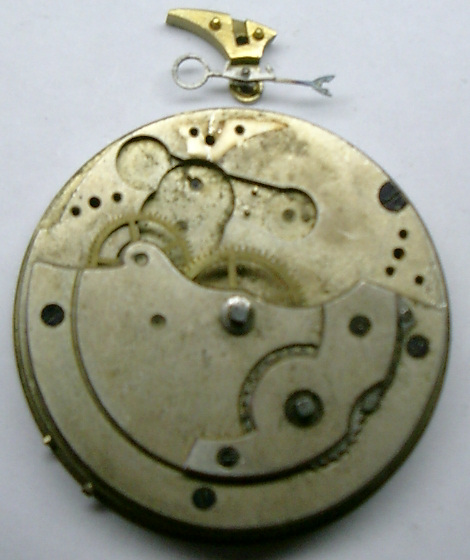 | ||||
|
Longines 'fixer upper/' escapement 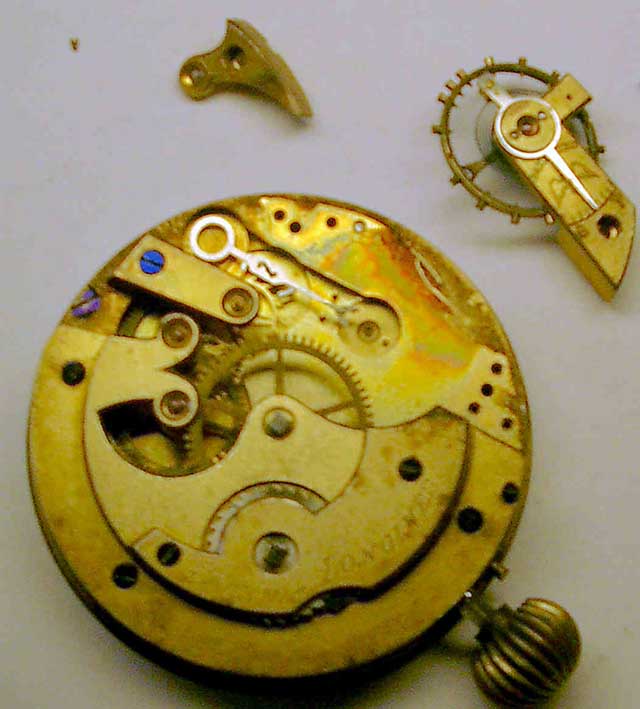 | ||||
|
| Life Achievement Military Expert |
The balance of the Longines (Longines marked) indicates that it was not one of their high end watches, but a watch of average quality. Thus, not suitable as parts for your high end admiralty watch. Doing the work yourself is a viable option, if you have the time and the skill. As you are aware, anyone working on a historic watch like this should follow the basic rule that whatever you add to the watch can be taken off without any changes being made to the original movement. The price quoted seems rather high to me, but then I tend to be rather conservative with valuations (and I'm cheap). For true value, consider that even after all the expensive time consuming work is done, it will never be 100% original. Given the time it would take a hobby watchmaker like me to make this watch work, I would seriously consider selling or trading the watch away. But then, that's me, all of our situations differ. Thanks for the update. What ever you might do with the watch, I hope you will keep us informed of the steps in the process. Best regards, Greg | |||
|
Values are always so slippery. There is the price you would expect to pay if you were to buy it in the fanciest antique shop in London; the price you would pay in a tatty shop in a small out of the way town; the price you would be paid by the fancy shop and the price you would be paid by the tatty shop; the value that you would need to know for insurance; the price you would pay at an auction attended by deep pockets, rabid expert collectors; the price you would pay at an ordinary auction with ordinary people; the price you would pay on Ebay; the price you would pay at a boot sale and the price you would be paid if you sold it to an honest dealer and the price you would be paid if you sold it to a greedy dealer. From the lowest to the highest of these is typically a factor of about 300% and often much more. For example, an insurance appraisal is always a minimum of double the cost it would take to buy it in a store. The fanciest shop in London will almost always be double what it would sell for at auction since the shop not only needs to make a handsome profit but they have to pay those high rents and other costs of doing business for their location. While I think your watch is really nice, I would agree with Greg that the value that was mentioned to you seems quite high in terms of what you would likely get for it in an auction or by selling it to someone at auction or thorough some other method. Is that fellow actually offering you that amount of money or is he merely telling you it is "worth" that amount? I've noticed that the market for pre-WW I timepieces has not really taken off like the ones that were actually used in WWI or WW II has. For the most part their value seems to be more in their non-military desireability as examples of watches made by their makers than having much bonus value for the military connection. Perhaps now is a good time to buy up these oldest military watches, though of course there is the risk that they may go nowhere in prices for many years to come. One of the main attractions to me for military timepieces is the ability to imagine they were actually used for the purpose for which they were intended - in battle helping their user in their personal struggle to win the day. For me, it is this romanticism that transforms a clock or watch into something with added value. Of course there are many collectors for whom this is not their main interest, but I know I am not alone in my reasons for collecting military time pieces and in part this is a reason why military clocks and watches from the wars have been going up in prices. | ||||
|
Greg, Jim, Thanks for the input, much appreciated, I'll certainly add updates as and when something happens, may be a while though. The value quoted to me was based on a running watch and what could be expected. I got the impression the guy was quoting realised values from his own sales. He does have a London shop, website and no doubt a big network of 'well heeled' buyers and dealers ..plus watchmakers of the highest order, I've little doubt that watch would be done PDQ and sold on for mega - bucks. Even though this watch doesn't have any wartime provenance, they still don't pass this way in this condition very often and there are folks out there that will pay a premium for that. (I've just gotta find one) If he had offered me that much though, it'd still be in his fridge cooling from me low running to his shop with it The Longines and parts watches won't be used to finish it, but they do give me patterns to work around now, as I'd no solid idea of how the lever and pallets of that type would have been constructed in that era. I need to research which type pallets would likely have been used in the conversion though - steel or jewels, it will affect the construction of the lever itself, and it needs to be 'Right'. Looking at the watch plate, there is an area milled out next to the escape wheel, which suggests the actual pallets are below the lever, so would probably have been a one piece steel job like the Longines. Reversability of any work won't be a problem, as it's a philosophy I apply anyway to all repairs I do. All the work that's needed though is to add stuff that's missing rather than change anything. I can't comment either way on the quality of the Longines as I've nothing to compare it with. It seems to be an early model, as it appears to predate jewelled pallets and overcoil hairsprings which I believe later models have, also has a basic roller table and upright locking finger, not at all like later Swiss levers. I fully understand your sentiment about handling a wartime relic though Jim, and must confess, when holding one of my old WW11 watches, I often pause for thought about what it must have seen in its life - if only some of them could talk! I don't get that when handling the 'White', just wonder why work stopped! For the time being anyway, it's tucked up cosy in its bed again and looks like being there a little while longer. Back to the bench! Best regards John | ||||
|
Hi All, I'm going to go with steel pallets on the watch when I get started on it, I feel pretty certain now it's what would have been fitted. I've managed to turn up a Swiss lever watch with jewelled pallets rather than steel, and they're mounted in the side of the lever, not under it which is how my watch would have to be. All levers I've found so far with the pallets below the lever are steel. I've posted shots of an English lever of the type, and the jewelled Swiss lever version below. Best regards John 1st shot is the English lever & Escape Wheel, 2nd is the Swiss jewelled equivalent (first I've seen).  | ||||
|
Jewelled Swiss Lever & Escape Wheel 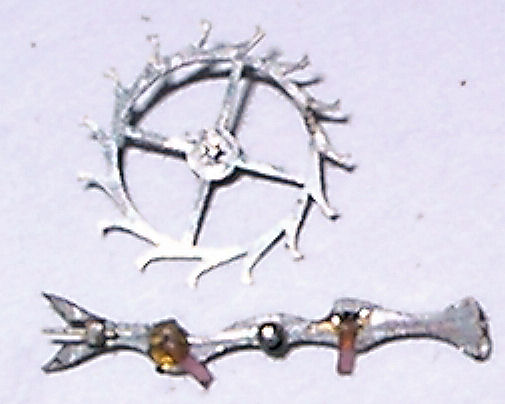 | ||||
|
Just read through all of this. Very interesting. I can't help much apart from adding a third type of pallet. I have a watch with pallets that look like steel at first glance, picture 1, but when you look closer it has jewels set in slots in the steel lever. The jewels are the same shape as the steel so the lever looks like solid steel but in fact there is a jewel where the escape wheel touches it. No doubt a more expensive option reserved for better quality movements. | ||||
|
Thanks for the input Stephan, The types of lever you mention, do have 'slips' of Ruby inserted into slots which are milled into the pallet faces too. It's not clear in my English Lever example shown above (photo 1), but this one is actually equipped with the type of jewelling you describe too (unfortunately I've been unable to edit my older postings to correct the description). I'll try to insert photo's of both types in my other topic. Some levers of this type though, just have polished faces, so the jewelled type is a further refinement. I'm fairly sure my watch would have been kitted out with pallets similar to those shown in photo 1, simply based on seeing good quality examples of 'Regulated' English Lever movements. What I haven't seen though, are clear examples of Freesprung types to see what was generally used. I've tried contacting a few 'experts' who would and most likely Do know, but all they want me to do is ship the watch to them with a view to purchase! Hmmm! Thanks again. John | ||||
|
Sorry Stephan, my camera just isn't up to taking good enough macro shots of the different pallet faces. When blown up enough to be visible, they're too blurred to make out. John | ||||
|
| Powered by Social Strata |
| Your request is being processed... |
|
Welcome Aboard IHC185™  Internet Horology Club 185
Internet Horology Club 185  IHC185™ Discussion Site Main Page
IHC185™ Discussion Site Main Page  Horological Discussions, Questions and Answers
Horological Discussions, Questions and Answers  Military Timepiece Discussions - EXCLUSIVE!
Military Timepiece Discussions - EXCLUSIVE!  H.White & Co Ltd, London. Pre-WW1 P.W.
H.White & Co Ltd, London. Pre-WW1 P.W.
 Internet Horology Club 185
Internet Horology Club 185  IHC185™ Discussion Site Main Page
IHC185™ Discussion Site Main Page  Horological Discussions, Questions and Answers
Horological Discussions, Questions and Answers  Military Timepiece Discussions - EXCLUSIVE!
Military Timepiece Discussions - EXCLUSIVE!  H.White & Co Ltd, London. Pre-WW1 P.W.
H.White & Co Ltd, London. Pre-WW1 P.W.©2002-2025 Internet Horology Club 185™ - Lindell V. Riddle President - All Rights Reserved Worldwide

